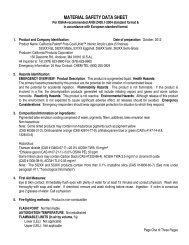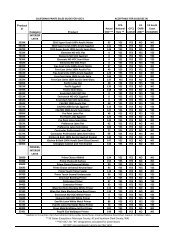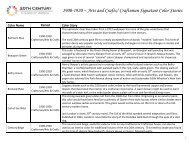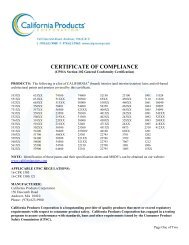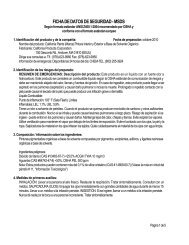MSDS - California Paints
MSDS - California Paints
MSDS - California Paints
Create successful ePaper yourself
Turn your PDF publications into a flip-book with our unique Google optimized e-Paper software.
6. Accidental release measures:STEPS TO BE TAKEN IN CASE MATERIAL IS RELEASED OR SPILLED: Remove all sources of ignition (flame, hot surfaces, andelectrical, static, or frictional sparks). Avoid breathing vapors. Use self-contained breathing equipment. Ventilate area. Containand remove with inert, absorbent material and non-sparking tools. Avoid contact. WASTE DISPOSAL METHOD: Disposal shouldbe done in accordance with Federal (40CFR Par 261), State and Local regulations. Before attempting clean-up, refer to hazardcaution information in other sections of the <strong>MSDS</strong>. Use licensed hazardous waste disposal concern.7. Handling and Storage:PRECAUTIONS TO BE TAKEN IN HANDLING AND STORING: Do not store or use near heat or open flame. Refer toOSHA 79CFR Part 1910.106 for specific storage requirements. Keep closure tight and container upright to preventleakage. Drums of this material should be grounded and bonded when pouring. Do not weld or flame-cut an emptydrum. OTHER PRECAUTIONS: Do not get in eyes. Avoid skin contact. Can cause allergic respiratory reaction. Cancause allergic skin reaction. Prevent prolonged or repeated breathing of vapor or spray mists. Do not handle until themanufacturer’s safety precautions have been read and understood. Avoid breathing sanding dusts.8. Exposure Controls/Personal Protection:RESPIRATORY PROTECTION: Use (MSHA/NIOSH-approved or equivalent) chemical/mechanical filters designed to remove acombination of particulates and organic vapor in open and restricted ventilation areas. Use approved airline-type respirators orhoods in confined areas.VENTILATION: Sufficient ventilation, in pattern and volume, should be provided to keep the air contaminant concentration belowapplicable exposure limits. Heavy solvent vapors should be removed from the lower levels of work area, and all ignition sources(non-explosion proof equipment) should be eliminated if flammable/air mixtures will be encountered. All application areas shouldbe ventilated in accordance with OSHA regulation 29CFR Part 1910.94.PROTECTION GLOVES: Gloves should be worn if skin contact is likely. Use neoprene or rubber gloves to prevent skin contact.EYE PROTECTION: Use safety eyewear including side shields, face shields, or chemical splash goggles (ANSIZ-87.1, or approvedequivalent).OTHER PROTECTIVE EQUIPMENT: Use disposable or impervious clothing if work clothing contamination is likely. Use protectivecream if skin contact is likely. Use full face shield, apron or other appropriate equipment.HYGIENIC PRACTICES: Wash hands before eating, smoking, or using the wash room. Do not smoke in any chemical handling orstorage area. Food or beverages should not be consumed anywhere this product is handled or stored.9. Physical and Chemical Properties:Forms: Viscous liquid, slight petroleum odorDensity: Varies with productBoiling Point of major constituent (mineral spirits): 150-190°FVapor Pressure (mm Hg) Mineral Spirits: 2mm @ 68°FVapor Density: (Air = 1), heavier than airSolubility in water: NilEvaporation Rate (Butyl acetate=1): 0.1310. Stability and Reactivity:Stability: Hazardous polymerization will not occur. Stable. Hazardous reactions: Avoid high temperatures, amines, acids,hydroxyl or other active hydrogen compounds. Hazardous Decompositions Products: Incomplete combustions may producefumes, smoke, carbon monoxide and other asphyxiates.Page Two of Four Pages





